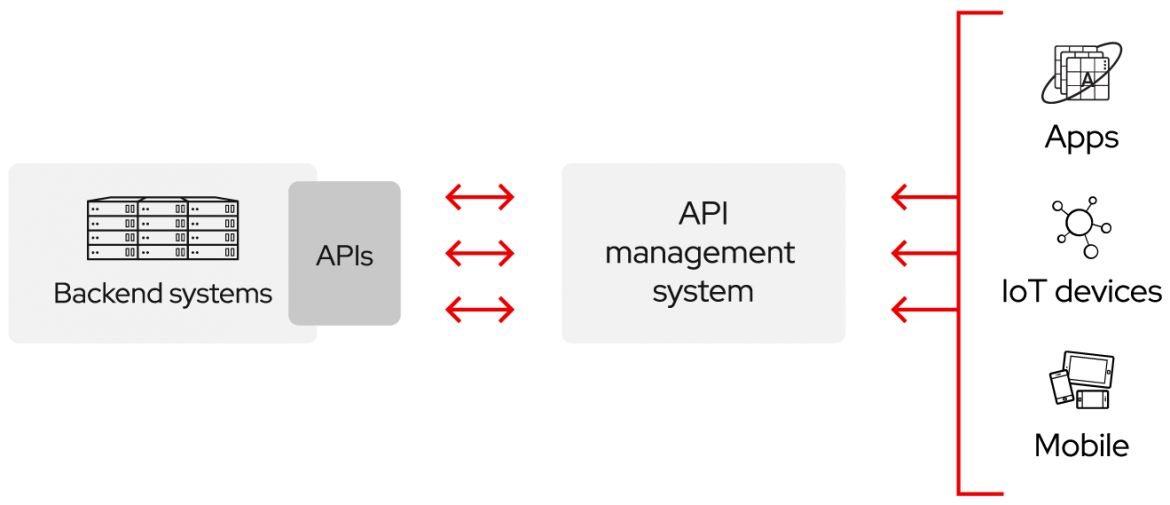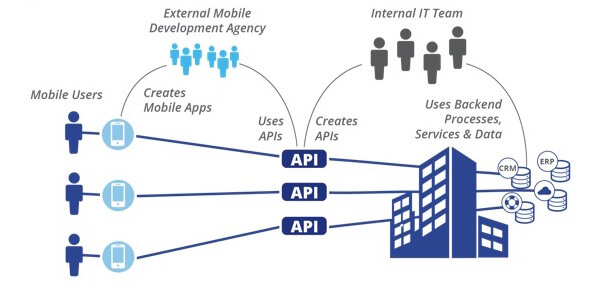The once-common practice of operating large, monolithic software systems supported on-premises is quickly changing. With the adoption of the cloud, microservices, and the new API economy, once slow-moving organizations, are being challenged to accept new methodologies and tools to become increasingly agile and keep up with the competition. Learn more about how to build faster, more secure APIs, and how to improve your API management with the help of TxMQ.
What is an API?
An API is a set of definitions and protocols for building and integrating application software. API stands for “application programming interface”.
APIs let your products or services communicate with other products and services without having to know how they’re implemented. This simplifies application development, saving time and money. When you’re designing new tools and products, or managing existing ones, APIs give you flexibility; simplify design, administration, and use; and provide opportunities for innovation.
APIs are sometimes thought of as contracts, with documentation that represents an agreement between parties: If party 1 sends a remote request structured a particular way, this is how party 2’s software will respond.
Because APIs simplify how developers integrate new application components into an existing architecture, they help business and IT teams collaborate. In order to stay competitive, it’s important to support the rapid development and deployment of innovative services. Cloud-native application development is an identifiable way to increase development speed, and it relies on connecting a microservices application architecture through APIs.

APIs are a simplified way to connect your own infrastructure through cloud-native app development, but they also allow you to share your data with customers and other external users. Public APIs represent unique business value because they can simplify and expand how you connect with your partners, as well as potentially monetize your data (the Google Maps API is a popular example).
Collaboration with External IT Agencies
What’s an Effective API Strategy?
An effective API strategy means a quicker time to market. Also, it means greater flexibility and more integration options. All of this is made possible with the right partner, and a solid plan for API Management. Managing your APIs properly can help unlock the creative potential of next-generation application developers, paving the way for new revenue streams and models
APIs have become the preferred method for synchronous interaction among microservice architectures. These APIs are the glue that connects all of the microservices together. Managing these APIs allows a company to assure the APIs are used in compliance with corporate policies and allows governance by appropriate levels of security, as some services may require different security policies than others. By implementing new strategies to manage APIs in response to rapid changes, and adopting a microservices architecture in order to meet demands to speed up software development, you are enabling rapid changes.
Effective API management calls for intricate planning and execution of unique and unconventional IT skills. Using APIs isn’t the hard part. Rather it is defining the outward and inward-facing processes that manage the life-cycle of API usage that will determine your company’s success. TxMQ works with companies of all shapes and sizes to leverage and harness the API economy.
What is your API strategy?
Maybe you’ve recognized the growing tension between line-of-business (LOB) decision-makers and your IT decision-makers, typified by LOB lead projects with minimized dependency on IT. Due to this, the practice of Bimodal IT has emerged as a method to support rapid application development, without disruption to maintenance and operational projects. The intent is to develop Systems of Engagement giving you, as the end customer or ‘real world’ face of a business, a greater than usual degree of agility. Back-end Systems of Record are critical, but often heavy, entrenched and slow to change. API Management can serve as the clean hand-off point that can help streamline the relationship between LOB-lead projects and core IT.
The once-common practice of operating large, monolithic software systems supported on-premises is quickly changing. With the adoption of the cloud, microservices, and the new API economy, once slow-moving organizations, are being challenged to accept new methodologies and tools to become increasingly agile and keep up with the competition. Learn more about how to build faster, more secure APIs, and how to improve your API management with the help of TxMQ.
What is API Management?
API management is identifying and managing the process of creating, distributing, and deploying application programming interfaces (APIs), controlling access, analyzing usage, and reporting performance. Without the proper API Management tools in place, it’s difficult for organizations to monitor API activity and ensure security, as well as the needs of developers and applications using the connectors, are being met. Newer hybrid and multi-cloud environments can make it even more difficult to manage APIs.
Having centralized control of your APIs is crucial to your success. Your API management solution should provide flexibility, dependability, speed, and most importantly security. Specifically, it should include a secure developer portal, API Gateway, Lifecycle Management, Analytics, and support for API monetization.
There are many management tools from vendors offering great solutions to help you, on your path into the new API economy. Solutions such as Red Hat 3scale API management platform, IBM’s API Connect, and Microsofts’ Azure API Management, are very popular but there are also many lesser-known solutions available. With no lack of choice, it can be difficult to find the right solution for you and your organization. Reach out to TxMQ to learn more about how to improve the management of your APIs and the tools available that will work best for your organizations plans.
Tooling
TxMQ supports a variety of vendors API tools, with particular focus on IBM. IBM’s App Connect Enterprise (ACE), and API Connect are two powerful tools our teams can help you acquire, architect, deploy and support.
How we can help with your API strategy.
Service discovery makes this easier. API management provides the necessary discovery mechanisms to ensure that available microservices can be found and that the documentation on how to use them is shared through the developer portal.
Microservices require an integrated approach to security. Security mechanisms differ depending on the type of API. External facing API services require different security mechanisms than internal ones. For less mission-critical APIs, simple protection with API keys is usually sufficient. With external or critical APIs, a more secure approach, like OAuth, will be required. We specialize in knowing what type of encryption and security protocols to use. Reach out to TxMQ today to learn more about how to improve your API Management.




